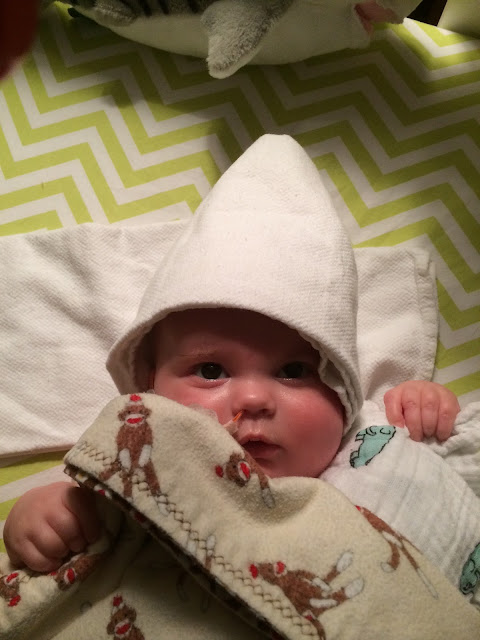Last week's tests of Sam's spinal fluid and bone marrow were not positive for HLH. That is, they showed no direct evidence of hemophagocytosis, the process whereby Sam's white blood cells attack his own body. This is good news, of course, but it doesn't seem to have been enough to convince our doctors that HLH isn't still sniffing around.
 |
| This view of Sam's bone marrow from June shows hemophagocytosis in action. The large, Pac Man-like white cell is devouring cells that it's supposed to leave alone. This was proof-positive of HLH back in June. Last week's bone marrow biopsy didn't show this, but as Carl Sagan apparently said, "Absence of evidence is not evidence of absence." |
Many of the other bio-markers the doctors look at for evidence of inflammation are also inconclusive. They could be evidence of something else--if not something benign, then at least something expected given Sam's post-transplant condition, side-effects of the meds he's on, etc. So, with every symptom, lab, or test result the winds seem to shift a little bit. Right now it seems like the doctors don't feel they have enough evidence to begin an all-out assault on the HLH (that might not really be there), but they have put Sam back on a pretty high dose of steroids (dexamethasone) in order to subdue any inflamed white cells that might be HLH.
We are not happy about this--the steroids weaken Sam's bones, contribute to hypertension, and probably impede Sam's ability to fight his cold--but I suppose it's better than a positive identification of HLH. If we do see definitive evidence of the disease, then we face a Sophie's Choice of sorts. We can treat with steroids and more chemo, which would effectively undo the transplant we just went through (because the brand new immune system we just gave Sam would be damaged, if not completely wiped out, by the chemo), and that would require him to endure some or all of this process all over again. Which, in turn, would subject him to more meds and their side-effects, make him vulnerable to infection, etc.
Or, we can bide our time and hope that Sam's immune system grows quickly enough on its own that it can knock out the disease, whatever there is of it, before it starts trying to eat him alive again. And that is a race that Sam might not win.
Needless to say, we're hoping that the soft evidence is not, in fact, disease-related and will fade as Sam gets stronger. In the meantime, however, we're watching Sam very closely and crossing our fingers that the reason we don't see stronger evidence of HLH is because it isn't there.
The continued uncertainty is nerve-wracking, but there are some good signs. First and foremost, the transplant itself appears to be very much on track. The donor cells are very well engrafted and Sam's blood counts are coming up faster than expected. His white cell count continues to rise, as does his platelet count. This is exactly what we want and need to happen.
Sam has stopped vomiting, and the quick but sometimes extreme bouts of discomfort he was having last week have disappeared. We're not sure what was going on in either case, but it's nice that he's more comfortable than he'd been, and great to have his awake and alert time filled with curiosity and smiles rather than cries of pain.
Finally, from the "good-news-if-dodging-a-very-big-bullet-is-still-considered-good-news file"...
Last week one of the overnight nurses saw what she thought might be seizure-like activity when she noticed Sam's arm extended and trembling rhythmically. Seizures are a possible HLH symptom, so the docs ordered an EEG with video so they could monitor Sam's brain waves. Sam's head was wired up so that he looked like some sort of electric Einstein (or Medusa?), then watched for 12 hours overnight. The video showed three occasions where Sam's arm did the trembly thing, but there was nothing in his brain activity to suggest that it was abnormal. This was an enormous relief for obvious (and some not-so-obvious) reasons. Suffice it to say that we had a pretty shitty 24 hours waiting for those results to come back.
Now if we can just get Sam to kick his cold, we might actually be able to take him home.
 |
| Sam is a boy... |
 |
| ...who adores his mom. |
















